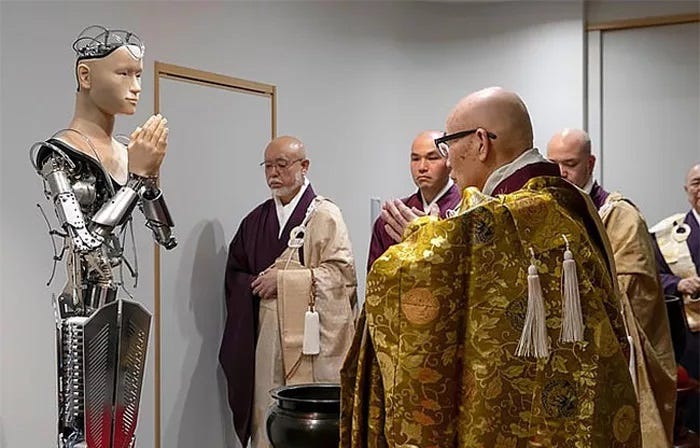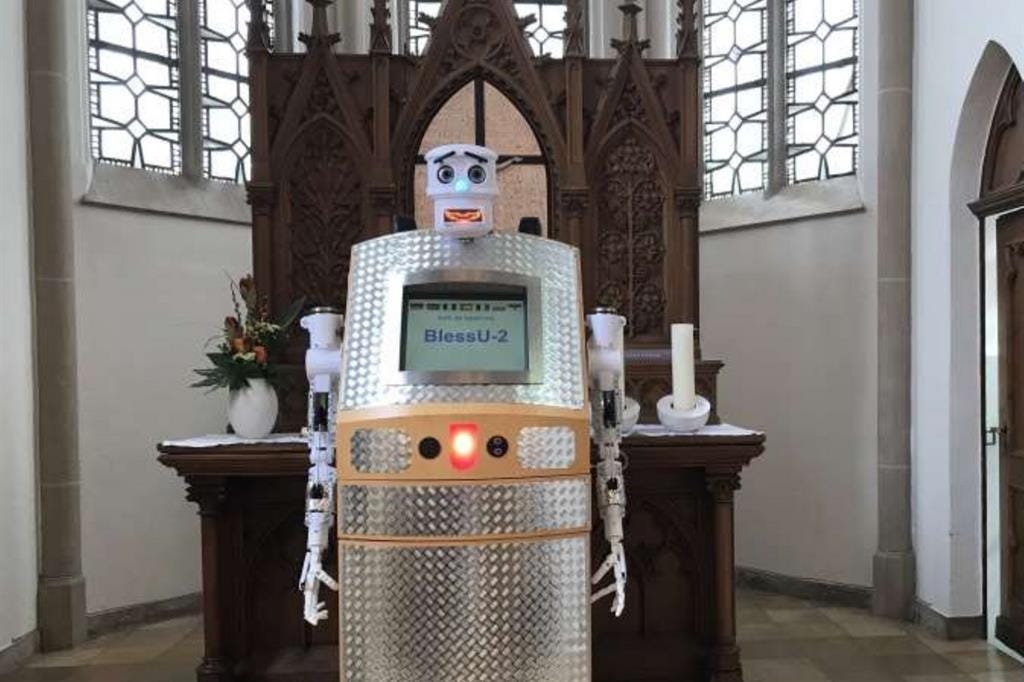The Neon God
Paul Kingsnorth at The Abbey of Misrule

Four Questions Concerning The Internet, part two
The most jarring thing that happened to me last year was nested within the most profound. In the summer, I spent five days as a pilgrim on Mount Athos, the Orthodox monastic republic in Greece, which for a thousand years has survived wars, pirate raids, church controversies and threats from hostile forces ranging from the Ottomans to the Nazis. I wrote about my experience here. It created a deep impression. Five days was barely enough to scratch the surface, which is why so many pilgrims end up returning, often repeatedly.
A place like this is inevitably romanticised, and you’ll often hear Athos referred to as ‘medieval.’ The few filmmakers who get permission to film there like to angle their cameras so as to emphasise the donkeys and candlelight and play down the cars and coffee machines. It’s true that Athos is much simpler, quiter, more beautiful and more ascetic than the modern world, as you would expect from a place inhabited entirely by monks. But these days, it also has buses, paved roads, imported food, computer terminals, solar panels and - much to my personal distress - mobile phone masts.
All of this is fairly new. The first landline telephone was only installed on Athos in 1995, to some controversy. Just thirty years ago there was very little electricity, and most travel was by foot or mule. But Athos has been modernising. Big money has flowed in from some governments and the EU, and the sound of car engines, which had never been heard at all until the 1990s, is now almost as common in some places as the sight of cranes. But it was the intrusion of the digital into the Holy Mountain which shocked me most. The first time I saw an Athonite monk pull a smartphone out from the pocket of his long black robes, I nearly fell over backwards.
There was something about this experience which really hit me. In practical terms it can, no doubt, be explained or justified; anything can if you try hard enough. But the pit that appeared in my stomach when I first saw a monk on the Holy Mountain with one of those black mirrors in his hand came from an instinct I’ve long had: that the sacred and the digital not only don’t mix, but are fatal to each other. That they are in metaphysical opposition. That what comes through these screens bleeds out any connection with the divine, with nature or with the fullness of humanity. Seeing smartphones in a place so dedicated to prayer and to God: I don’t mind admitting that it was a blow. Even here, I thought, even them. If even they can’t make a stand, who possibly could?
What I learned from that experience is that my belief in the profanity of technology is not widely shared, and that even people who I imagined would have a serious critique of technology often simply don’t. You might expect religious leaders to be clued up about the dark spiritual aspects of the technium, but while there have been astute religious critics of the Machine - Wendell Berry, Ivan Illich, Jacques Ellul, Philip Sherrard and Marshall McLuhan have all made appearances in these essays - most religious leaders and thinkers seem as swept up in the Machine’s propaganda system as anyone else. They have bought into what we might call the Myth of Neutral Technology, a subset of the Myth of Progress. In my view, true religion should challenge both. But I think, as ever, that I am in the minority here.
Still, on this issue as on so many others, the Athonite monks remain the conservatives. In Buddhist Japan, things are much further ahead, as you would probably expect. They don’t just have smartphone monks there; they have robot priests. Mindar, pictured below, is a robo-priest which has been working at a temple in Kyoto for the last few years, reciting Buddhist sutras with which it has been programmed (you can watch it performing on film here.) The next step, says monk Tensho Goto, an excitable champion of the digital dharma, is to fit it with an AI system so that it can have real conversations, and offer spiritual advice. Goto is especially excited about the fact that Mindar is ‘immortal.’ This means, he says, that it will be able to pass on the tradition in future better than him. Meanwhile, over in China, Xian’er is a touchscreen ‘robo-monk’ who works in a temple near Beijing, spreading ‘kindness, compassion and wisdom to others through the internet and new media.’

It’s not just the Buddhists: in India, the Hindus are joining in, handing over duties in one of their major ceremonies to a robot arm, which performs in place of a priest. And Christians are also getting in on the act. In a Catholic church in Warsaw, Poland, sits SanTO, an AI robot which looks like a statue of a saint, and is ‘designed to help people pray’ by offering Bible quotes in response to questions. Not to be outdone, a protestant church in Germany has developed a robot called - I kid you not - BlessU-2. BlessU-2, which looks like a character designed by Aardman Animations, can ‘forgive your sins in five different languages’, which must be handy if they’re too embarrassing to confess to a human.

Perhaps this tinfoil vicar will learn to write sermons as well as ChatGPT apparently already can. ‘Unlike the time-consuming human versions, AI sermons appear in seconds – and some can be quite good!’ gushed a Christian writer recently. When the editor of Premier Christianity magazine tried the same thing, the machine produced an effective sermon, and then did something it hadn’t been asked to do. ‘It even prayed’, wrote its interlocutor; ‘I didn’t think to ask it to pray…’
Funny how that keeps happening.
On and on it goes: the gushing, uncritical embrace of the Machine, even in the heart of the temple. The blind worship of idols, and the failure to see what stands behind them. Someone once reminded us that a man cannot serve two masters - but then, what did he know? Ilia Delio, a Franciscan nun who writes about the relationship between AI and God, has a better idea: gender-neutral robot priests, which will challenge the patriarchy, prevent sexual abuse and tackle the fusty old notion that ‘the priest is ontologically changed upon ordination.’ AI, says Delio, ‘challenges Catholicism to move toward a post-human priesthood.’
‘Behold,’ intones BlessU-2, quoting the Book of Revelation, ‘I make all things new.’
Part one of this essay offered up the suggestion that the global digital infrastructure we are building looks unnervingly like the ‘body’ of some manifesting intelligence that we neither understand nor control. I suggested that if we view the digital revolution in spiritual rather than materialist terms, we will have a better chance of seeing it for what it is. See the Internet as the inevitable result of eating the fruit of the knowledge of good and evil, rather than the fruit of the tree of life - see technological ‘progress’ as a result of choosing information over communion - and the story that emerges is the Faustlike summoning of something we are not nearly big enough to be playing with.
Most people, I have no doubt, would dismiss this kind of talk as overblown at best and mad at worst. Certainly you can find a thousand think pieces all over the web telling us to chill out about the rise of AI. Calm down, they all say, stop all the Matrix talk. There are dangers, yes, but this is just hysteria. Notably, though, as we saw last time, the people actually running the show do not talk like this. In contrast, they are ‘kept awake at night’, as Google’s CEO put it last week, by the fear of what they are creating. For a radical example of this, take an essay recently published in the usually staid Time magazine, in which AI researcher Eliezer Yudkowsky, regarded as a leader in the field of Artificial General Intelligence, responded to the recent call for a moratorium in AI development.



